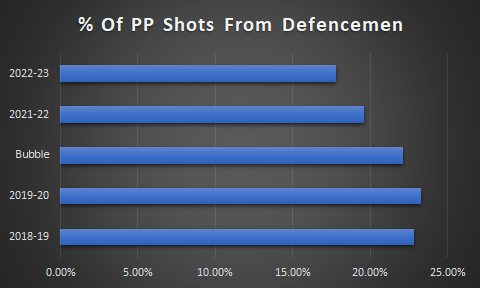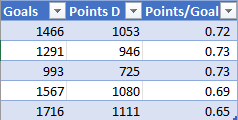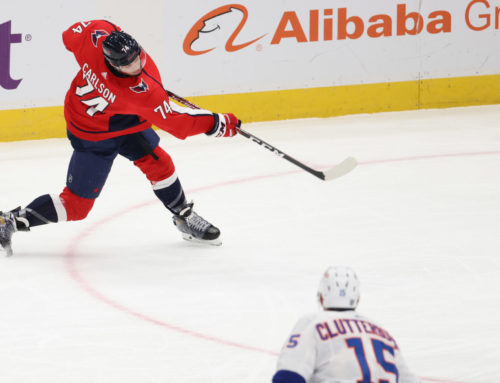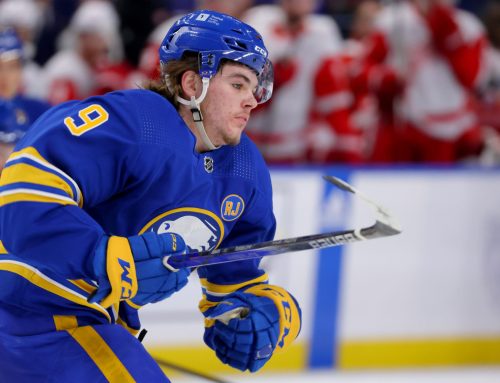Not that it was in doubt, but Connor Bedard signed his entry-level deal with the Blackhawks, ensuring he'll be in the lineup on opening night. The future has arrived for Chicago.
When he was drafted, I looked at how recent super-elite draft picks have fared in their rookie seasons. There is upside to be had, but it's also a matter of where his ADP ends up. As one example, to be a top-50 skater by Yahoo! scoring in 2022-23, a forward almost certainly needed 30 goals and 70 points. There were a couple exceptions like Joe Pavelski with 28 goals and Adrian Kempe with 67 points, but Pavelski was also plus-42 while Kempe had 41 goals and 250 shots. If Bedard's ADP is anywhere inside the top-60 players off the board in a multi-cat format, and league scoring holds over, his stat line has to be, at a minimum, 30 goals, 40 assists, 200 shots, and 20 PPPs. There is room for fluctuation – 37 goals and 32 assists probably gets it done, for example – but those should be seen as baselines for a top-60 ADP using Yahoo!'s scoring system.
We obviously have to wait for September to see where Bedard's ADP falls, just beware of how high the bar for production is now, especially for a skater to be a high-end option in multi-cat one-year leagues.
*
Oliver Wahlstrom signed a one-year qualifying offer, so he’s locked in for 2023-24. I’ll have more on Wahlstrom in a piece next week, but he is a player I’m incredibly interested in, fantasy-wise, for the upcoming season.
*
Ross Colton signed a four-year, $16M extension with the Colorado Avalanche. He was moved by Tampa Bay as the team faced a cap crunch, and it's clear the Avs think he's a big part of their Cup window. Where he slots remains to be seen but hopefully it's in a higher role than what he had with the Lightning. I'm a big believer in his multi-cat value for the next few years.
*
I enjoyed Dobber's Ramblings yesterday looking at some odd offseason movement. The one that stuck out to me was Alex Killorn. Listen, he's made good money already, has his championships, and probably just wants to play somewhere warm as he winds down his career. Good for him on getting that, and another real big chunk of change. And I guess Anaheim wanted some championship pedigree, or something, but Pierre-Edouard Bellemare was there for one year at well under $1M, Ryan O'Reilly was available for $1.75M less per season, while Brian Dumoulin only got two years. All these guys are Cup winners and would have been much less expensive, and mostly for fewer years, than Killorn. It is a weird, weird signing at that length and AAV.
*
Last week, we spent three different Ramblings talking about changes in stat levels across the league. There were paragraphs about how goals and assists aren't rising at the same rate, how blocked shots exploded, and how hit levels are varying among production levels. Visit our Ramblings section to dig in further.
One fantasy stat that was discussed briefly but not expounded upon was power play production. The importance of power-play points has never been more obvious, so dedicating one (or more) Ramblings specifically to this area is the proper approach.
Let's look at the change in PP production over the years and how that applies to defencemen in particular. As usual, data will be from our Frozen Tools or Natural Stat Trick unless otherwise indicated. When discussing the power play, it's often at 5-on-4 only, but today we'll be including all power plays, all PP goals, and all PP points.
Just a cursory look at Hockey Reference shows that the 2022-23 season saw a big jump in both power-play opportunities and conversion percentage:

On a practical level, the rise in goal scoring took the average skater's goals/60 minutes on the man advantage from 1.42 in 2018-19 to 1.55 this past season. In other words, the rise in PP scoring has raised the average player's goal rate by 9.2%. That is a lot.
It is defencemen that are the focus of the article today, though, so let's drill down there.
A rise in goal scoring across the league will naturally lead to more point production. More total points obfuscate what is actually happening, though. Even with a jump in goals, and defencemen being more involved in the play at all strengths, goals from defencemen fell. Here are the totals for defencemen on the power play over the last five years with a couple highlights:

Notice the red boxes. Total shots from defencemen on the power play fell from 2021-22 to 2022-23 despite 360 extra minutes of PPTOI. The green box from 2019-20 shows more shots from defencemen, compared to 2022-23, even though blue liners had an extra 1743 minutes of PPTOI in the latter season. Even with many more opportunities, the share of goals from the blue line on the power play fell from 14.7% in 2018-19 to an even 10% in 2022-23.
We can't solely blame a shift to 4F-1D power plays here (though that has caused PPTOI changes for a lot of defencemen and we'll get back to that). As mentioned, total ice time by defencemen rose with the man advantage. The additional PP opportunities will boost the ice time anyway, but there is a genuine shift in how teams approach the power play in recent seasons. The change has been steady, but the last couple of seasons have been drastic:

This is all intuitive to anyone that's watched the NHL over the last few years, but fewer shots from the point mean fewer goals from the point. Not only that, but very few defencemen are capable of switching with a forward on the power play to move to a better scoring position. Guys like Cale Makar and Roman Josi do this, but it isn't frequent. This is where we note that a lot of this is related to fewer overall defencemen getting meaningful PPTOI, largely thanks to the shift to more 4F-1D power play setups rather than the defencemen getting PPTOI actually shooting less.
Point production has also fallen. This is where things may start to get counter intuitive. These last several Ramblings have shown defencemen getting more involved with the overall play, and there were more PPPs than ever from the blue line, but their rate production on the power play has tanked. Here are the rates of defence points per goal scored on the power play over the last five seasons:

As recently as the Bubble season, defencemen registered 0.73 points on every PP goal their team scored. For every 1000 PP goals scored, that is 730 points. Just last season, that fell to 0.65 points/goal, or 650 points on every 1000 goals scored. There are more PP points in total, but the rise in PP production among defencemen lags considerably behind the overall rise in scoring. Had it stayed constant, there would have been an extra 137 PP points from defencemen in 2022-23. But it didn't, so there's not.
There is also a concentration of roles. Back in 2018-19, there were 69 defencemen with at least 100 PP minutes played. The number of d-men to reach 100 PP minutes in 2022-23 fell to 59. That is where the strategic change from 3F-2D power plays to 4F-1D power plays becomes more visible. It also means the middle class of PP producers from the back end has started disappearing:
- Defencemen that had between 25-150 minutes of PPTOI in 2018-19 averaged 4.9 PPPs.
- Defencemen that had between 25-150 minutes of PPTOI in 2022-23 averaged 3.7 PPPs.
The exact same class of defenceman, four years apart, saw their production drop by 26%.
All this should help inform fantasy owners about what to do with defencemen in drafts. Finding guys at the end of fantasy drafts that can put up 7-8 PPPs, to contribute a little, are less frequent than any point in recent memory. It gives a little bit more value to stalwarts like Adam Fox, Makar, and Josi.
It was just mentioned how the lower-class of PP producers on the blue line has been shrinking. That is part of the shift from 3F-2D power plays to 4F-1D power plays. Each season from 2018-2021 saw defencemen earn at least 25% of the total PPTOI available. That fell to 23.2% in 2022-23. The power plays are more productive than at any time in the last couple decades, but there is less opportunity for defencemen to actually earn that ice time. It's a quandary.
To that last note, there were 85 defencemen to play at least 40 games and average over 1 minute of PPTOI per game back in 2018-19. The number of defencemen to do that in 2022-23 was 71, and that's with Seattle added to the league. More power-play opportunities than any time in the last seven seasons, an extra team in the NHL, and the number of defencemen with a meaningful PP role fell by 17% in four years. That is a drastic change.
Earlier, I mentioned how these things can place extra value on the reliable top PP guys like Makar and Josi. The reason for that is if you don't have one of those productive PP defencemen, it's hard to make up the deficit elsewhere. Our most recent season saw a dozen blue liners pass 25 PPPs. If a fantasy owner is in a 12-team league and has none of the top PP producers, there's almost no hope of making it up in chunks with moderate producers. A huge leap in league PP production means too much ground to make up and not enough options to do it without hitting on the perfect combination of mid-tier producers. It isn't necessary to draft Cale Makar in the first round of every draft, but it's likely a good idea to grab someone like Adam Fox, Rasmus Dahlin, or Quinn Hughes early on. Otherwise, fantasy owners are going to have to strike it rich with a lot of the 10-20 PPP guys. Unfortunately, there are 11 other fantasy owners in your league trying to do the same thing, and they have a 30 PPP advantage at that point.
There are several avenues of success in any fantasy league. It isn't a must that fantasy owners get one of the top PP guys in the first few rounds; ask anyone who drafted Victor Hedman last year how that went. It will take a few breaks to succeed without one of those guys, though.
We'll stop here for today. A quick recap:
- Additional power-play opportunities and an increased conversion rate have led to more goals and points. That includes production from defencemen, but how that production is distributed among PP defencemen has changed.
- Despite all the additional PP chances, the share of ice time available to defencemen is falling. That limits the secondary options.
- Defencemen are taking lower and lower shares of power play shots each season. It is largely a function of the change in power-play formations.
- There are more high-end PP blue liners than any point in recent history, but there are also fewer in the middle- and lower-classes. That means it's hard to chip away at power-play point deficits once they start growing during the fantasy season.
- Even the middle- and lower-class defencemen getting PPTOI are producing less on a per-season basis. A lot of small-space play by the forwards on the man advantage could easily be a cause here.
Alright, that's it for today. We'll be back tomorrow with some secondary PP defencemen to target.





 TOR
TOR S.J
S.J ANA
ANA EDM
EDM CAR
CAR DET
DET CGY
CGY VAN
VAN MIN
MIN
